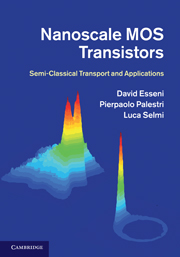Book contents
- Frontmatter
- Contents
- Preface
- Acknowledgements
- Terminology
- 1 Introduction
- 2 Bulk semiconductors and the semi-classical model
- 3 Quantum confined inversion layers
- 4 Carrier scattering in silicon MOS transistors
- 5 The Boltzmann transport equation
- 6 The Monte Carlo method for the Boltzmann transport equation
- 7 Simulation of bulk and SOI silicon MOSFETs
- 8 MOS transistors with arbitrary crystal orientation
- 9 MOS transistors with strained silicon channel
- 10 MOS transistors with alternative materials
- Appendices
- Index
3 - Quantum confined inversion layers
Published online by Cambridge University Press: 05 August 2011
- Frontmatter
- Contents
- Preface
- Acknowledgements
- Terminology
- 1 Introduction
- 2 Bulk semiconductors and the semi-classical model
- 3 Quantum confined inversion layers
- 4 Carrier scattering in silicon MOS transistors
- 5 The Boltzmann transport equation
- 6 The Monte Carlo method for the Boltzmann transport equation
- 7 Simulation of bulk and SOI silicon MOSFETs
- 8 MOS transistors with arbitrary crystal orientation
- 9 MOS transistors with strained silicon channel
- 10 MOS transistors with alternative materials
- Appendices
- Index
Summary
The working principle of MOS transistors requires formation of an extremely thin layer of carriers at the semiconductor-oxide interface. This is obtained by means of an appropriate gate bias, which produces a narrow minimum of the carrier potential energy at such an interface, resulting in an inversion layer with significant quantization effects.
The carriers in such inversion layers are essentially free to move only in the plane parallel to the silicon-dielectric interface. The allowed energy states stemming from either the conduction or the valence band of the underlying crystal form subbands, inside which the energy depends on a quasi-continuum two-dimensional wave-vector k, so that the carriers are said to form a two-dimensional (2D) gas. The energy dispersion in the 2D subbands is very important to describe the electrostatics and the transport in MOS transistors and it depends both on the confining potential and on the characteristics of the underlying crystal.
This chapter presents the fundamental concepts and the models to determine the energy relation and the carrier densities at equilibrium in the inversion layer of both n-type and p-type MOS transistors.
After introducing the basic concepts related to subband quantization in Section 3.1 by using a pedagogical example, Section 3.2 discusses the application to an electron inversion layer of the effective mass approximation (EMA) approach (see Section 2.4). Then Section 3.3 presents the extension to hole inversion layers of the k·p model introduced in Section 2.2.2; a simplified semi-analytical model for the hole energy relation is also discussed.
- Type
- Chapter
- Information
- Nanoscale MOS TransistorsSemi-Classical Transport and Applications, pp. 63 - 111Publisher: Cambridge University PressPrint publication year: 2011



